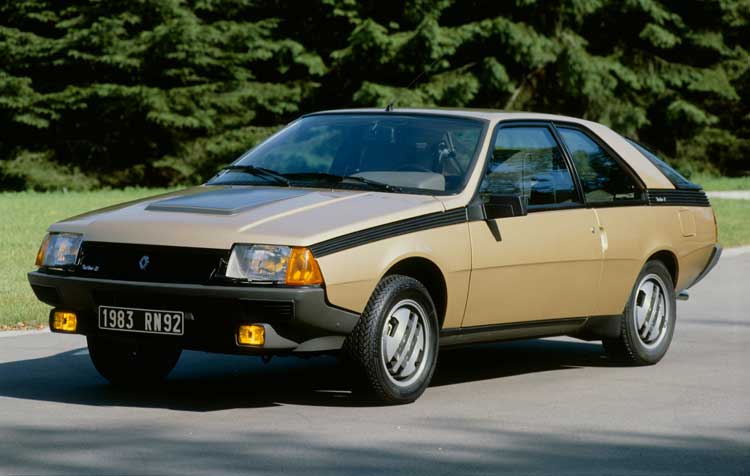Renault Fuego
This cool French rival to the Capri should have been loved more by its parent, says Giles Chapman

Renault yanked the wraps off its Fuego in March 1980 - and rapped the knuckles of anyone who tried to explain that this unusual four-seater coupé was derived from the Renault 18 saloon. Which was annoying, because most of the hardware under those bulbous, aerodynamic lines did, indeed, come straight from France's equivalent to the Ford Cortina.
The company was on the defensive from the word go, when the mood should, instead, have been celebratory. After all, that great motoring sage, the late LJK Setright, declared: "It is blessed with a body which is not only roomy and aerodynamically efficient, but is also beautiful".
Corporate pride, you understand, intervened between the Fuego and the general public. Those interesting lines were the work of one Robert Opron, the urbane genius behind the Citroën SM and CX, two of France's all-time great contributions to the pantheon of car design. That thick, black plastic belt-line encircling the Fuego looked like it came from a giant marker pen, but it was at least from an august marker pen. Still, the "C" word; Renault was never going to acknowledge its bitter rival Citroën for providing any creative heritage...
The Fuego, therefore, suffered under a sulky atmosphere for the whole of its life. It parked uncomfortably in Renault's line-up of mediocre family cars, a sore thumb with a proper, emotive name (it's Spanish for fire) instead of a number like the 5, 9, 18 or 25. When it was dropped in Europe in 1987, Renault didn't even bother to replace it.
That was a shame, because the Fuego was a decent stab at a front-wheel drive rival to the Ford Capri. The lack of a propshaft and the panoramic goldfish bowl-like glass rear hatchback meant that there was a proper amount of room in the back for two full-grown adults.
And, like the Capri, the engine range went from an economical, low-hassle 1.4-litre motor, giving 64bhp for the TL and GTL trim levels, up to a 110bhp 2-litre for the TX and GTX.
But that was only at the start. In 1984, Renault gave us the Fuego Turbo, with a blown 1.6-litre engine putting out 132bhp through desperately scrabbling front wheels as the torque-steer did its un-level best to hamper every smooth start. An obscenely huge sticker on the doors read "TURBO" for the benefit of anyone who hadn't already guessed. Happy days!
Nor was the turbo the most interesting engine. A year before, Renault had slotted the 18's 2.1-litre turbo-diesel into the Fuego. With 88bhp, it was a reasonable performer of its type, but is more significant for being, I believe, the first vaguely sporting car with an oil-burning power unit.
And the innovations didn't stop there, either. In the electronic spirit of the early 1980s, the Fuego was (once again, I would love to be proved wrong) the first car with a remote central-locking system, while the Turbo came with a largely pointless on-board trip computer to fiddle about with while waiting at traffic lights to floor the throttle once more.
In truth, the Fuego was not the committed performance driver's choice. The spongy MacPherson strut suspension, betraying the Renault 18 within, had been devised for comfort and not for being hurled in and out of tight corners at speed. There was little of the finely tuned and supple Golf GTi to the car, and hot hatchbacks like that were, by then, rapidly overshadowing cars such as the Capri, Manta and Fuego. However, on smooth, straight roads, the Fuego's stability and ride was excellent, probably thanks also to a low drag factor of just 0.34.
The Fuego was axed from French production lines in 1985, although it was made in Spain until 1987, and spent its twilight years in Argentina, where it was produced as the Fuego GTA Max until 1993 with a 2.2-litre engine. While a South American career for Renault cars of the time was expected, a North American one was not.
Nevertheless, between 1982 and 1985, the Fuego was sold through American Motors dealers and given a fuel-injected 2.2-litre engine. But at the same time it was saddled with protruding bumpers that, while able to spring back into shape after a 5mph nudge, did nothing either for the car's looks or for streamlining.
An exact production total for the Fuego is impossible to come by, although we know that some 226,583 were made in France, with maybe another 40,000 hailing from Spain, Argentina and Venezuela. You'll search in vain for one of the few thousand models sold in Britain. Once the novelty of Fuegos wore off, they slipped into a used-car hinterland where depreciation was steeper than an average black run in the French Alps. Factor in rust, MoT failure and high insurance rates, and it quickly became easier to scrap than to sell. Seeing a Fuego slipping quietly along British roads today - well, that really is an unusual sight.
The car was paid an unusual compliment by no less than the mighty Toyota in 1993. The Fuego's slippery shape led Renault's marketing department to invent the slogan, "L'Aerodynamite" for the Turbo version in 1984. The British campaign included double-page Sunday supplement ads showing a black car photographed in a sultry, red-lit studio under the "Aerodynamite" banner.
Nine years later, either through total ignorance or else in the way of saluting a good idea, Toyota's Supra was advertised in double-page spread splashes, in black, back-lit in electric blue in a darkened studio. Underneath, the tag-line read... "Aerodynamite".
It's always a hard task to be distinctive in the car world, but Renault's Fuego definitely managed it.
Subscribe to Independent Premium to bookmark this article
Want to bookmark your favourite articles and stories to read or reference later? Start your Independent Premium subscription today.

Join our commenting forum
Join thought-provoking conversations, follow other Independent readers and see their replies